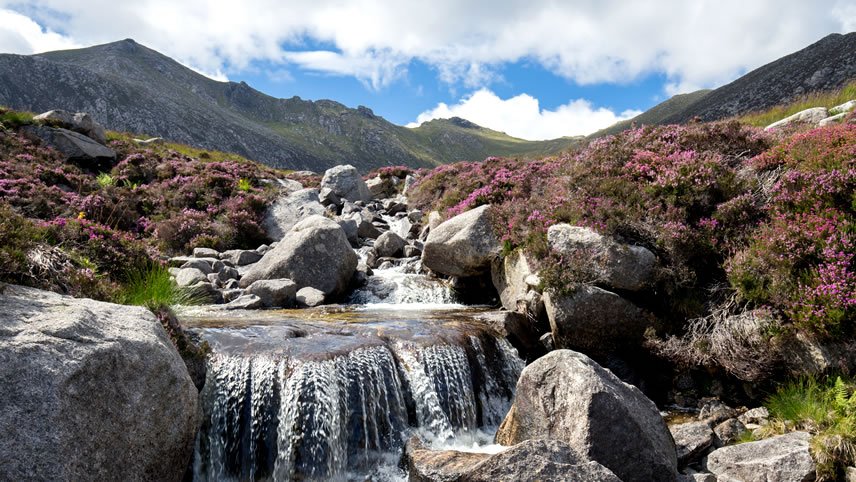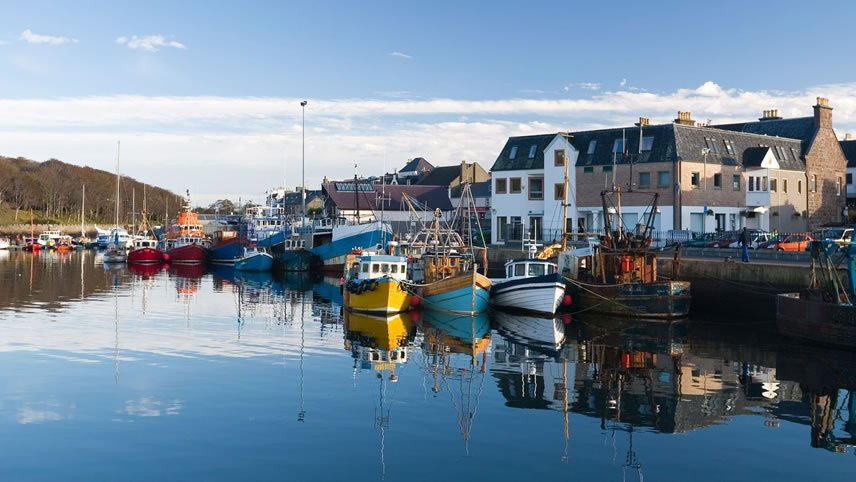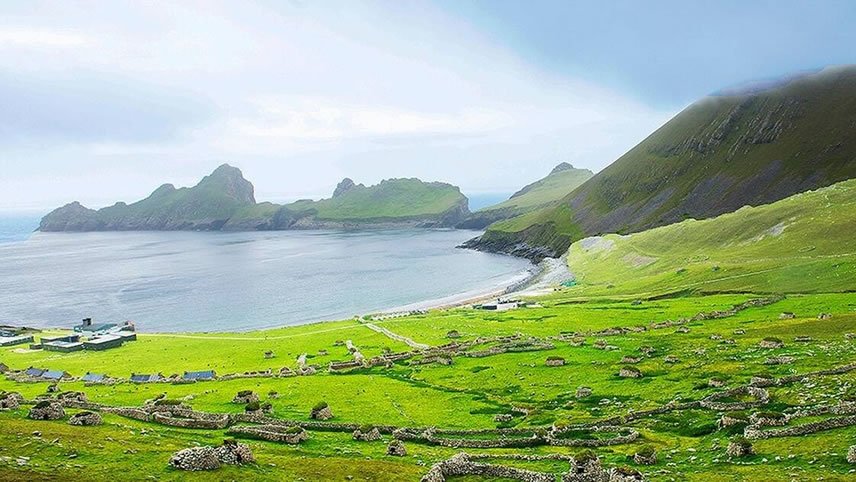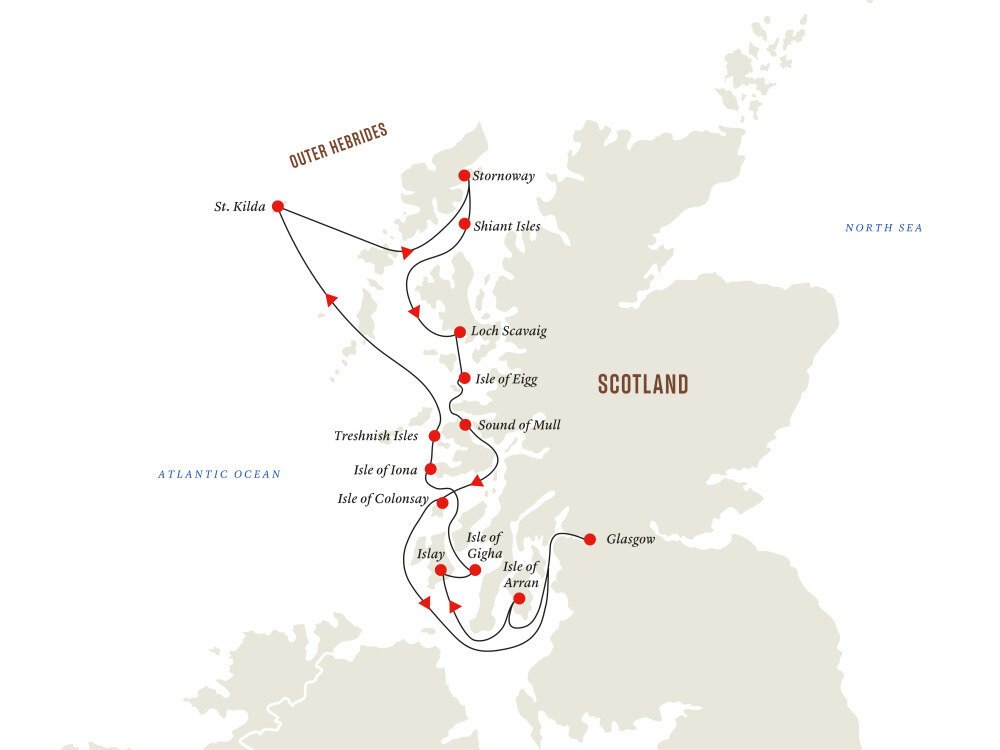Overview
Itinerary
Our Scottish Isles expedition begins in Glasgow. Set against a backdrop of splendid Victorian architecture, Glasgow has reinvented itself as a stylish and exciting city, full of museums, galleries, and lively spots to eat, drink and shop. This is definitely a city you’ll want to see more of if you have any spare time before the day of embarkation. Add an extra night and get to know the proud city of Edinburgh, uniting history and beauty. See the architectural gems with the magnificent 12th-century cathedral and revolutionary Art Nouveau buildings in Glasgow. The same tour if also offered as an optional Post-Programme.
Your comfortable expedition ship MS Spitsbergen will be ready and waiting for you. Once you board the ship and check in, you’ll receive your complimentary wind and water-resistant expedition jacket which may come in handy with the unpredictable weather we can expect to encounter along the way. There’ll be time to settle into your cabin and explore a bit of the ship before attending a mandatory pre-departure safety drill.
You’ll be greeted by your friendly Expedition Team. They’ll prepare you for the exciting days ahead, but their first priority will be to take you through important health and safety principles to ensure you and your fellow explorers are always safe and well throughout the cruise.
And with that, we’ll be away! MS Spitsbergen will set sail from Glasgow, heading north into the Atlantic on our circular voyage to explore the remote Scottish isles.
Stretch your legs out on deck and get to know the different areas of the ship, which is your new home-from-home for the next 11 days. Enjoy your first dinner aboard in one of the ship’s excellent restaurants, and look forward to many more delicious meals to come. Raise your glass and join the Captain and crew as they toast an enjoyable expedition together.
Please note, as this is an expedition cruise, the order of stops may change due to local circumstances.
Warmed by the North Atlantic Drift, this sheltered island with its high peaks is a haven for wildlife. Dramatic mountains, a distinctive distillery and good hiking trails all add up to a microcosm of Scotland. Brodick town has its 16th century red-sandstone castle whilst the ruined castle of Lochranza was once a royal hunting lodge.
As you step onto the beautiful isle of Arran, feel its unique atmosphere. More sheltered than the outer Scottish islands, Arran is covered in rich purple heather, with green and brown low hills, and is watered by numerous streams and small rivers. While you’re here, a hike is a must, with Goat Fell being a popular route.
Visit Brodick Castle and Gardens overlooking the Firth of Clyde in the island’s main town and get a sense of the aristocratic life of yesteryear. It’s the quintessential island castle, and in the grounds there’s a woodland and formal garden to explore and relax in.
A bit further away stands the Machrie Moor stone circle. The moor is littered with Neolithic treasures including burial cairns, cists and standing stones, but it’s the stone circle that most visitors make a bee line for. Check out the huge upright slabs and marvel at the skill and technique the ancients must have used to get them there.
Next, drop by at the Isle of Arran Distillery for a tour of the production process, rounded off with a snifter of their distinctive malt. All malts are unique, and Arran’s whisky starts life as pure water, cascading down through six waterfalls to reach the distillery. Try it for yourself!
As you travel around the island, see if you can spot Scotland’s ‘Big Five’ wildlife draws, the Golden Eagle, red deer, red squirrel, otter and seal – all of which live on Arran.
Fire up your spirit of discovery and step onto an island famed for its whisky, wildlife and woolly garments.
Islay isn’t called ‘whisky island’ for nothing. There are nine working distilleries here, and you’ll find their peaty single malts sold around the world. One of the larger isles, there’s 130 miles of coastline, and numerous quiet, sandy beaches.
History abounds on Islay, with ancient monoliths and a stone circle showing the island was inhabited back in Neolithic times. Later Islay came to be known as the Lordship of the Isles, and you can explore the enigmatic settlement at Finlaggan, which remains the most important archaeological site on the island, while a number of Celtic crosses can be found dotted around.
Islay is a wildlife paradise, with over 200 species of birds including oystercatchers, gannets, terns, shags and cormorants, as well as buzzards, Hen Harriers and even Golden Eagles. From the beaches, dolphins and basking sharks are sometimes spotted, and you might even see otters if you are patient.
Delve into the delights of the charming little town of Bowmore where there are shops, an interesting round church, plus several cosy pubs and restaurants. It’s probably the only place in the world you can grab a Hebridean pizza – or ‘peat-za’ – topped with crab and lobster.
Arts and crafts abound in Bowmore, and you can visit potters, quilters and artists in their workshops. Visit Islay Woollen Mill, near Bridgend, which made tartan clothes for Mel Gibson in Braveheart, as well as Liam Neeson’s kilt in Rob Roy.
Of course, no trip to Islay would be complete without a visit to at least one of its famous distilleries. Bruichladdich, Laphroaig, Bunnahabhain, Ardbeg and Bowmore are among the best known.
Tiny Gigha (pronounced Gee’a) is a little sandy slice of paradise. Nicknamed ‘Good Isle’, this tiny island is owned by the 163 residents, all of whom aim to create a ‘good life’ for themselves. It’s a place of quiet beaches, peaceful walks and tranquil views.
There’s only one village on Gigha and that’s Ardminish on the east coast. Pay a visit to Achamore House, about a mile to the south, which is set in fifty acres of woodland gardens and was once the home of Sir James Horlick. Sir James created a colourful and impressive display of rhododendron flowers (aka azaleas) – as well as the tasty, malted wheat drink we all know him for.
Take a walk along the coast and visit some of the white sandy coves to work up an appetite before dropping in on the quaint Boathouse Restaurant for a spot of lunch. This award-winning eatery is right on the shore and the chef serves up a range of tasty and fresh Scottish seafood, paired with a great wine list.
Gigha is a small island – only 6 miles long – and you can easily get around it on foot. If bike hire is available from the village shop, getting around on two wheels is lots of fun. You may want to head up to the back-to-back twin beaches of Bagh Rubha Ruaidh and Bagh na Doirlinne, which feature turquoise waters and amazing views.
Before heading back to the ship, stock up on locally made snacks and treats you’ll see for sale at honesty boxes by the roadsides all over the island, as well as the village store. The welcoming locals produce a distinctive waxed fruit cheese – give it a try!
Famed for its mystical Christian associations, Iona is a peaceful little island off the coast of Mull in the Inner Hebrides. The restored Abbey remains a place of pilgrimage and peace, but there’s much more to see here including picturesque beaches, wonderful wildlife and the beautiful St Columba’s Bay.
Iona has been a centre for Christian worship since the sixth century, but the Abbey was sacked several times by Vikings between 795 and 825. Today you can explore this sacred site, including the restored church. There’s said to be 48 early Scottish kings buried in the graveyard, as well as Irish and Norwegian ones – see if you can find them!
There’s a popular hike uphill to Dun I (pronounced Dun Eee) from the Abbey. You’ll be at Iona’s highest point and will be able to see St Columba’s Bay and the Treshnish Isles. Look out for ‘Natural Well’ aka the ‘Well of Eternal Youth’ and splash your face with its allegedly miraculous waters. It’s in a cleft between two rocks as you walk downhill facing North.
We’ll explore the remote beauty of the Treshnish Isles next, a group of distinctive skerries home to a wealth of wildlife, including Atlantic Puffins, colonies of Black-legged Kittiwakes, Razorbills, and Common Guillemots, as well as Atlantic grey seals. Did you know that puffins can live for 30 years or more?
Fingal’s Cave, immortalised in music by Mendelssohn’s Hebrides Overture, is on the cave-riddled island of Staffa and is noted for its amazing natural acoustics. The basalt columns within are a northern extension of the Giant’s Causeway in Northern Ireland. On a calm, clear day, it might even be possible to land and see the colour of the waters inside the cave, but its rising columns can also be viewed from the sea.
There’s only one way to describe tiny, rocky St Kilda: wild. As such, our visit to this storm-tossed archipelago, with its breath-taking sea cliffs and boiling seas is totally weather-dependent.
As a UNESCO double World Heritage Site and the jewel in the crown of the National Trust for Scotland, visiting St Kilda is an unforgettable experience. The outlying stacks and islands, which are the remains of a volcanic crater, provide ledges for thousands of nesting seabirds. What’s more, minke whales are sometimes seen in the swirling waters that surround the rocky outcrops.
Once home to Britain’s most remote island community, in 1930, after 4,000 years of continuous habitation, the people living on St Kilda’s Hirta Island were evacuated at their own request. The tiny museum that remains is a record of how hard life was on this exposed outcrop.
However, setting foot on St Kilda you’ll soon see the island is far from deserted – it’s home to a multitude of seabirds, including over 60,000 pairs of Northern Gannets – the second largest gannet colony in the world! There’s a good chance you’ll spot many other seabirds as well, including Atlantic Puffins, Northern Fulmars, Common Guillemots, and Black-legged Kittiwakes – you’ll soon see there’s a reason St. Kilda is considered one of the most important seabird colonies in Europe.
Birdlife aside, you might spot some other island inhabitants if you look. An ancient breed of sheep – the Soay sheep – lives wild here, as do a number of other rare species including the St Kilda mouse and the St Kilda Wren. See if you can find any of them!
Explore the abandoned village and see the distinctive ‘cleits’ – circular stone buildings used to store peat, eggs and smoked puffins, before heading back to MS Spitsbergen and its rather nicer dining options.
The Isle of Lewis & Harris is famed for pristine beaches, Neolithic sites and tweed workshops. Originally a Viking settlement, Stornoway is the main town on Lewis & Harris – a single island with two names denoting the north and south parts. It’s the largest and most northerly island in the Outer Hebrides.
Check out Lews Castle, an impressive Gothic-revival style which overlooks Stornoway Harbour. You can wander round the grounds and get unbeatable views of the inky blue seas, or why not drop in for a wee dram in the castle’s very own whisky bar.
Harris is famed for its woollen tweed fabric, and you’ll see jackets, trousers and hats for sale in shops all over the island – perfect for gifts or mementoes. After visiting shops, museums and old castles, blow the cobwebs off with a walk.
Of course, a visit to Lewis & Harris wouldn’t be complete without seeing the Callanish standing stones (Calanais in Gaelic), a magical ring of monoliths whose origins are shrouded in mystery.
Later in the afternoon, we explore the Shiant Isles, a tiny archipelago set in the Minch strait. There is only one habitable structure here, a simple bothy for sleeping in. Privately owned since 1937, these wild and beautiful islands are one of the most important breeding colonies for seabirds in Europe.
Hundreds of thousands of seabirds arrive here each spring and summer to breed, including 10 percent of UK Atlantic Puffins and 7 percent of UK Razorbills, as well as European Shags, Common Eiders, Northern Fulmars, and Common Guillemots. At this time of year, you can see the birds throng in surrounding waters or nest on volcanic ledges. Keep your eyes open for the “bully” of the seabird world, the Great Skua!
Beneath the dramatic peaks of the Cuillin Mountains, Loch Scavaig on the Isle of Skye leads to one of the most beautiful and dramatic freshwater lochs in Scotland – Loch Coruisk. Painted by Turner and a popular destination for the Victorians, this is a powerful and romantic landscape that will get your heart racing.
You’ll need your walking boots on to allow for the sometimes-soggy conditions, but there are several great walks alongside the loch. The name Coruisk means ‘Cauldron of Water’ and you might feel like you’re in an epic fantasy film as you set foot upon its shores. Surrounded on three sides by craggy peaks, there’s a lost world feel here, and the poet Tennyson described it as “the wildest scene in the Highlands.”
Later, we head to the remote and craggy Isle of Eigg, one of the least visited of the Western Isles. Just five miles long by three miles wide, the island has a fascinating 8,000-year history and is home to incredible wildlife.
Eigg has been inhabited for over 8,000 years and is now owned by the local community. The island has Iron Age forts, a 6th century church, and an interesting but turbulent clan history to learn about.
Birders will be in for a treat as 130 bird species are recorded here. You might spot the Golden Eagle, White-Tailed Eagle, Red Throated Diver and the Stonechat. Near the shoreline, you can often spot seals, dolphins and porpoises.
You can enjoy strolls along white sand beaches like Bay of Laig or take a longer walk to a quartz beach where the sand sings! On a clear day, you can hike to the top of An Sgurr, the rocky outcrop that dominates the island. You’ll be rewarded with stunning views across the Minch to the Outer Hebrides.
Today we’ll anchor in the Sound of Mull, allowing us to explore the picturesque town of Tobermory on the Isle of Mull, and Loch Sunart.
The Isle of Mull is a large island of sweeping moors, featuring tiny hamlets and castles. Tobermory, a charming, deep-water fishing port, is the island’s main town. It’s instantly recognisable from the row of brightly-coloured Georgian houses that line the waterfront in the tiny bay.
Nestled beneath steeply rising hills, this welcoming town offers a good variety of cafés, restaurants, bookshops and craft stores. You can visit the town’s whisky distillery and pop into the tiny Mull museum for a snapshot of local history. Take a stroll around the loch in Aros Park and see the Baliscate Standing Stones.
The Isle of Mull is a magnet for birders, especially those with a keen eye for eagles. Not only does it have the highest breeding density of Golden Eagles in Europe, it has also successfully nested 20 pairs of White-tailed Eagles, that can often be seen soaring above the island’s indented coastline.
Stretching inland across from Tobermory and protected by the rugged point of Ardnamurchan, lies Loch Sunart. The deep, sheltered waters of this long, narrow loch make it ideal for sea kayaking and fishing, while its shores offer tranquil walks along woodland trails. The mix of salt water from the Atlantic and fresh water runoff creates an ecosystem that attracts lots of wildlife, especially otters.
Guarding the entrance to the loch stands Mingary Castle. Hexagonal in shape, with nine-foot-thick stone walls, the 13th century castle now conceals a luxury hotel. Over the centuries, the castle has been fought over by a succession of clans, prized for its strategic location and access to the Sound of Mull.
We spend today enjoying the unspoilt beauty on the Isle of Colonsay. Get ready for some incredible coastal walks along endless stretches of white sand! Kiloran Bay and Plaide Mhòrare are particular highlights, with breath taking views of the neighbouring islands on a clear day. Your solitude will be interrupted only by seabirds, seals, the occasional otter and perhaps a cow.
You can also enjoy some wonderful kayaking in the surrounding waters, and you may even catch sight of whales, porpoises and dolphins as you paddle.
Colonsay’s variety of natural habitats attracts an enormous range of marine life, plants and also birds. You might spot choughs, Red Northern Divers and eagles. Listen out for the rasping rattle of the rare and elusive corncrake, the most famous of the island’s avian inhabitants! Fulmars, guillemots, Razorbills, kittiwakes and shags are among the birds that nest on the dramatic cliffs on the west coast.
Home to around 135 people, Scalasaig is the main hub on the island, with basic amenities, a microbrewery, and even an 18-hole golf course!
The central part of the island and Colonsay’s sheltered bays benefit from an almost subtropical climate, allowing over 400 species of flora to bloom, including sea samphire and the rare orchid, Hooded Ladies’ Tresses (Spiranthes Romanzoffiana). Colonsay House, a beautiful Georgian country house, stands at the heart of the island, surrounded by a woodland garden.
If you’re happy to get your feet wet, at low tide it’s possible to make the trip across The Strand mudflats to Oronsay on the south of the island. After a 2.5-mile walk, you’ll reach the well-preserved stone ruins of Oronsay Priory, a 14th century Augustine monastery marked by a large Celtic cross. There, you’ll find cloisters and carved gravestones. Keep your eyes open for choughs and corncrakes whilst here.
Our island-hopping expedition ends where we started out, in Glasgow. We know you’ll have had some wonderful experiences over the past 11 days, but why not linger in Glasgow a while and see some of the things you may have missed before you departed on your expedition cruise. If you have more time it is worth extending your stay by booking our optional Post-Programme. Stay overnight in a historic and chic hotel and visit Edinburgh Castle, home of Scottish kings and queens for centuries.
The compact downtown area, offers plenty of shopping and dining options and is easy to orientate. You can walk up to the East End and visit Glasgow Cathedral, a shining example of Gothic architecture. Behind it stretches a 19th century Necropolis of Victorian tombstones to explore.
Head west from the centre to view the eclectic art and natural history collections of the Kelvingrove Art Gallery & Museum. Housed in a grand sandstone building set in the lush grounds of Kelvingrove Park, it’s a must see. In Glasgow Harbour, down by the River Clyde, you’ll be greeted by the striking, Zaha Hadid-designed Riverside Museum. Berthed alongside this impressive transport museum is the tall ship Glenlee.
Design fans will enjoy spotting the mark of Charles Rennie Macintosh dotted across the city. The unique Glasgow Style that he helped make famous together with his wife Margaret MacDonald, is heavily influenced by Art Nouveau and is distinguishable by its simplicity and stylised forms. Visit House for an Art Lover and Macintosh House to learn more about this creative architect and designer.
What better way could there be to round off your voyage of discovery around Scotland’s wonderful isles!
Life Onboard MS Spitsbergen

Intimately scaled and perfectly designed to take the scenic route; enjoy open viewing spaces and Scandinavian touches. Read more

Destinations come to life with a Guide Team on classic coastal voyages and an Expedition Team on expedition sailings. Read more

From cosy inside cabins to luxurious suites, the perfect home away from home awaits for every cruiser. Read more

Enjoy a delightful menu crafted from fresh ingredients and locally sourced produce served up in the main restaurant. Read more
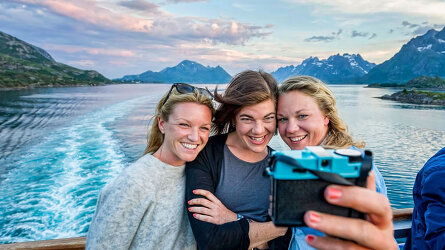
Enjoy Hurtigruten's famously relaxed atmosphere and cruise comfortably day and night, with no need to change for dinner. Read more

Make use of the wellness and recreation facilities on board, including a gym, sauna, and outdoor hot tubs. Read more

Availability Click on prices below to view cabin upgrades and details
Tour & cruises prices are per person. Prices shown have savings applied, are subject to availability and may be withdrawn at any time without notice. Prices and trip information are correct at the time at this point in time, however are subject to confirmation at the time of booking and are subject to change by Hurtigruten. For cruise itineraries, cabin images are sourced from Hurtigruten. These should be treated as indicative only. Cabin inclusions, upholsteries and room layout may differ to the image(s) shown depending on the ship selected and your sailing dates.
Similar Cruises
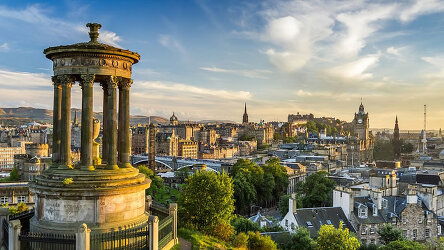
12 Days Dover Reykjavik
Operated By: Hurtigruten
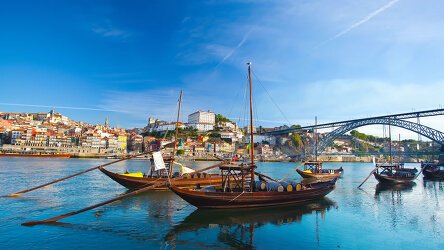
12 Days Lisbon Hamburg
Operated By: Hurtigruten

12 Days Hamburg Lisbon
Operated By: Hurtigruten
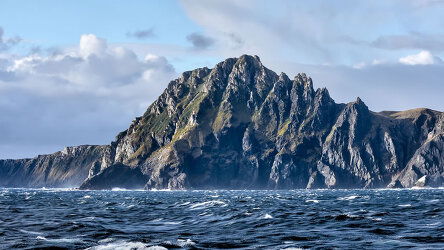
12 Days Buenos Aires Buenos Aires
Operated By: Hurtigruten
